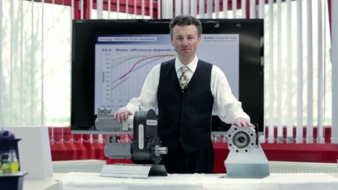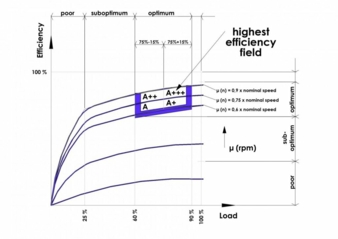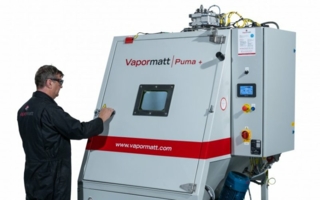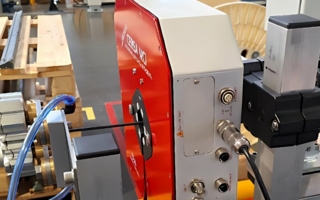25/03/2021 – Continuously Variable Transmissions (CVT)
Saving energy with networked CVT
Electric drive technology is one of the most widespread industrial technologies. This article from Kabel.Consult.Ing discusses how intelligent digital and energetic networking of a modular split-power CVT drive system on the “mechanical train side” can provide new functionality and increased value for machine manufacturers and operators.
Globally, electric drives convert more than 6,000TWh of electrical energy into mechanical output, an amount equivalent to approximately 27% of global power production [Source: Siemens]. The same is true for Germany, where industrial users account for 46% of total power consumption or approximately 250TWh (900petajoules). Seventy percent of this is accounted for by electric motors and electric motor systems (175TWh or 630petajoules) [Source: ABB].
Let’s take a quick look back
In 2015, European standard EN 50598 went into effect. It defines Ecodesign requirements for electric drive systems in low-voltage electrically driven machines. Accordingly, all products that utilize an appreciable amount of electrical energy must be evaluated for their efficiency or losses, respectively. But will this relatively young European standard have the last word?
What role will conventional drive technology play in the future in the context of trends such as IoT and Big Data, Industry 4.0, Industrie du Futur, Piano Nationale Impresa 4.0, Industrial Value Chain Initiative, Industrial Internet Consortium, and Made in China 2025?
Many current innovations depend on sophisticated sensors, generation and storage of data, edge and cloud technologies, and data transmission (including 5G). Statistical and mathematical algorithms, automation, and the emerging trend of artificial intelligence (AI) play supporting roles. In other words, a large portion of the functionality and associated customer benefits are realized through software and communication.
An Introduction to CVT technology
The use of mathematical and scientifically-based methods in the process of designing complex machines was first championed by Robert Willis (1800–1875) of Cambridge University and is one of the most important accomplishments of the late industrial era. During his time, he was a new breed of “engineer scientist” because he broke from the workshop tradition that had dominated mechanical engineering and embraced mathematics, engineering education, codification of mechanical practices, and scientific principals. With this new approach to mechanical design, Robert Willis greatly influenced generations of engineers. One of those engineers was Geoffrey Joseph Abbott, who in 1935 applied for a patent on a “mechanical continuously variable transmission”. So far, more than ten million CVTs have been sold around the world for use in industrial and especially automotive applications.
In 2004, the first German KfW energy efficiency prize was awarded to a twisted cabling machine that made use of a CVT process for production of wire cable (winding and stranding process). The jury included two luminaries of international energy research: Ernst Ulrich von Weizsäcker and Eberhard Jochem. By directing braking energy back into an on-site power network, the system reduced net power consumption by approximately 20%. During subsequent years, energy regeneration units (or the intermediate voltage circuit) have become standard equipment. With newer machines, where the unwinder (generator operated) and rewinder (motor operated) are energetically-linked via an intermediate voltage circuit, energy savings are known to be in the area of 40%.
In 2014, Kabel.Consult.Ing filed for patent protection of its Electronic Continuously Variable Transmission. It brings together the achievements of the first three industrial revolutions and sets the stage for the era of Industry 4.0. In formula form: Industry 1.0 + 2.0 -> fundamentals, pioneer achievements; Industry 3.0 -> semiconductor technology, PLC programming, CIM; and Industry 4.0 -> automation of intelligent behavior, programming of algorithms using statistics and mathematics.
Research conducted at University of Technology Sydney and Hunan University Changsha (2018) likewise concluded that mechanical CVT drive technology is the most efficient and economical way to power large and small electric vehicles.
Summary. Use of networked CVT technology can boost average efficiency of motors from well below 60% currently to 80% or even 100%, resulting in greatly increased total efficiency of motor- and generator-powered applications. This results in minimized energy costs, maximized energy outputs, and ultimately to standardization throughout a production plant. From a macro-economic perspective, (networked) CVT technology makes a valuable contribution to “decarbonization” and lower CO2 emissions.
CVT processes have become common in high-speed applications in the cable, wire, and stranding industry (ribboning, braiding, shielding, twist stranding, binding, winding)
To remain competitive, manufacturers have for decades sought to accelerate production by continually increasing the speeds of their cable and stranding machines. Higher speeds result in tremendous centrifugal and Coriolis forces that impart tension into the rotating elements. For these reasons, engineers have until now focused on optimizing the drives. Little by little, purely mechanical drives have been replaced by electric and then mechatronic solutions. In the cable industry, twist stranding and central winding spinners are important components in this effort.
Stranding machines, where twisting is accomplished with individual or group components or the cable itself, have been in vogue since at least the era of data cables (and no later than the hybrid cable era) due to their universality and variable ability to reverse direction. With twist stranding, the stranded elements are threaded through a stationary guide disc and fed to a (rotating) stranding nipple. As soon as the bound strands leave the nipple, a stranding rotor twists them together into a helix shape and guides them through a system of deflection rollers to the traversing spooling device. Theoretically, the product has reached its final condition long before the stranding rotor. This can be exploited by adding steps to the stranding process, such as filling with petroleum jelly, swelling powder, or talcum powder; insertion of insulation; longitudinal water sealing with film or tape; labeling; spinning with thread; and shielding with film, tape, or wire.
Central winding spinners are an important component of fiber optic cable stranding machines, on which the speed of an entire production line largely depends. A central winding spinner is used to twist a thread in a screw shape around the fiber optic cable. The spun material, e.g. aramid or cotton yarn, lies in the rotational axis and the cable is fed through the machine’s central opening. Next, during binding, the thread passes through a series of rollers, deflection rods, or thread guides, applying it to the cable in a helix shape. As the rotational speed of the central winding spinner increases, the cable machine's line speed increases automatically.
Until recently, having a refined CVT process with drive and control components optimized for the machines and parameters was decisive for boosting productivity and effectiveness of mechanical processes in cable production.
Intrinsic advantages of networked CVT drive technology
Conventional systems are characterized by “one motor, one transmission, one inverter” and follow European standard EN 50598. By contrast, a networked CVT drive consists of: at least one servo amplifier/inverter; two rotary current servo motors, rotary current asynchronous motors, or synchronous reluctance motors; and a planetary linkage via a heavy-duty timing belt. Substantially higher overall efficiency is the result. This makes it possible to use lower-output motors with reduced operating costs, leading to several intrinsic advantages:
– optimization of drive performance with a motor-driven application and therefore minimization of energy costs;
– optimization of generator output with a generator-driven application and therefore maximization of energy output;
– standardization of the drive components on an individual machine, in a single system or department, in the entire plant or company, in one industry, nationally and internationally;
– standardization of new services, products, and business models related to the IoT trend “networking and digital transformation in drive technology";
The advantages of the overall drive system are the same as for all modularization efforts.
– For machine developers: lower development costs, economies of scale in production, multiple series of the same type, and consistent and therefore simpler assembly processes.
– For machine operators: the ability to exchange single faulty modules makes repairs fast and economical. Compatibility and reuse of components minimizes spare-part stocking expenses.
– Consistent modularity greatly increases clarity and acceptance both on the manufacturer (sales, assembly, startup, spare parts service) and user (purchasing, operation, maintenance) sides.
What role will classical mechanics and electronics play in the digital era? Networking and digital transformation, combined with business models based on new service opportunities are very important for any national economy. But solutions designed to boost sustainability of resources, energy efficiency, or the recycling economy will continue to grow in significance. Accordingly, mechanics as well as electrical, drive, and mobility technology will remain the heart of industrial production.
Kabel.Consult.Ing
Reststrauch 55
41199 Mönchengladbach/Germany
Contact person is Juan Carlos González Villar
Tel.: +49 2166 912620
gonzalez@kabelconsulting.de
www.kabelconsulting.de





